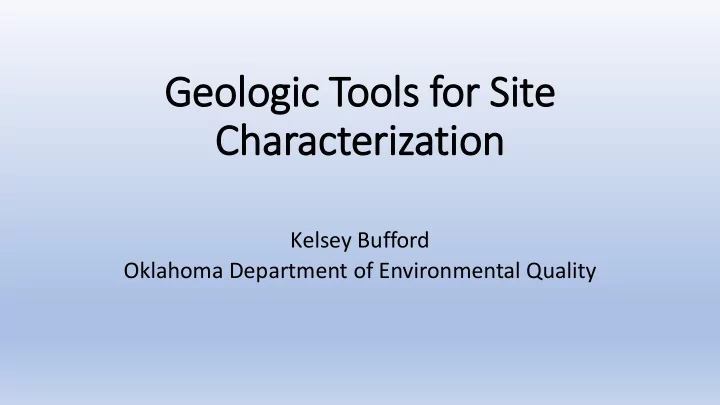

Geologic Tools for Site Characterization Kelsey Bufford Oklahoma Department of Environmental Quality
Oklahoma Department of f Environmental Quality (O (ODEQ) and th the US Environmental Protection Agency (U (USEPA) Collaborative Demonstration Collaborators : USEPA Region 6 USEPA Office of Research and Development Objectives: • Determine utility of various characterization tools for use during remedial investigation • Improve hydrogeologic conceptual model
Site Location • Eagle Industries is located at 10901 SE 29th Street in Midwest City. • Eagle Industries inspected and repaired aircraft oxygen and fire extinguisher systems for third party customers from 1990 – 2010s.
Site History ry • In 2003, an ODEQ site inspection found improper handling practices of the chemical trichloroethylene (TCE). • TCE was found in soil and ground water on site. • Eagle Industries entered into a legal consent order with ODEQ to address environmental concerns and performed some work to clean up the site. • In 2009, ODEQ determined that the facility had a limited ability to pay for any additional environmental cleanup work at the site.
Site Description Groundwater Monitoring Well • Eagle Industries is in the Remedial Investigation Network (RI) phase of the Superfund process • Subsurface soil and groundwater contamination: Volatile organic compounds • Complex hydrogeologic setting: Interbedded coarse and fine-grained materials in recharge area of Garber-Wellington Aquifer • Groundwater flow and contaminant distribution not well defined
Geologic Framework Characterization Borehole Geophysics Objectives: • Define fine grained (silt/clay/shale) and coarser grained (sand) aquifer materials near monitoring wells • Identify variability of subsurface materials between monitoring wells • Identify semi-confined or perched units and other controls on groundwater flow Methods Demonstrated: Natural Gamma and Electromagnetic Induction (also known as Conductivity)
Borehole Geophysical Logg gging – Id Identify fy Vertical and Lateral Changes in in Lit ithology Tool - Natural Logging Results and Gamma, Induction Interpreted Geology Conductivity and Resistivity Silts & Clays Sand Silts & Clays Geophysical Logging Trailer
A’ A A’ Geophysical Logs • Lithology varies vertically and laterally A • Some wells screened across more than one sand unit (e.g., MW-4 and DEQ-2) • Acquiring geophysical logs before well installation may prevent screening across multiple sand units
Geologic Framework Characterization Surface Geophysics Objectives: • Define fine grained (silt/clay/shale) and coarser grained (sand) aquifer materials between wells • Identify semiconfined or perched units and other controls on groundwater flow Method Demonstrated: Electrical Resistivity Imaging (ERI)
Electrical Resistivity Survey Results • Prominent sand body in NW portion of the site becomes discontinuous towards SE. Sands (more resistive) Silt/Clay/Shale (more conductive) NW SE
Hydrologic Characterization Objective: • Identify possible groundwater flow directions and connections/disconnections between hydrologic units Methods: • Periodic manual depth-to-water measurements in all existing monitoring wells • Long-term high frequency measurement of water levels using pressure transducer/data loggers
Hydrologic Characterization Lo Long-Term Trends in in Cu Current Sit Site Well lls Shallow Perched Water Table Wells Cross-Connecting Different Units? Wells Screened Across Regional Water Table Differences in response to precipitation may indicate presence of different aquifer units
Hydrologic Characterization Groundwater Flo low Dir irectio ions Regional Aquifer Potentiometric Surface November 15, 2018 Estimated Groundwater Flow Directions Periodic water-level measurements allow preliminary estimation of groundwater flow directions and seasonal variations (Contour Interval = 0.1 ft)
Demonstration Results • Different trends in groundwater elevations indicate there may be separate aquifer units with poor communication between them • Zone(s) of perched water may overlie the regional aquifer • Geophysics indicates separation of sands by silts/clays/shales in some areas • Groundwater in the regional aquifer may flow in west to southwest directions from the site (preliminary estimates)
Conclusions • Cooperative demonstration of technologies was a success. • Viable characterization methods were identified. • Results improved understanding of hydrogeologic controls on groundwater flow. • Improved understanding of geologic framework should allow for a more focused remedial investigation.
Acknowledgements • Katrina Higgins-Coltrain, USEPA Region 6 • Randall Ross, USEPA Office of Research and Development • Steve Acree, USEPA Office of Research and Development
QUESTIONS?
Recommend
More recommend